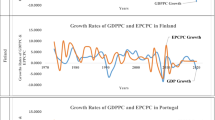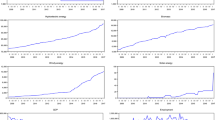Abstract
Despite consistent investments, grants, and other concessions in the power sector, nationwide power outages still remain an issue, even in 2020, disrupting business operations, contributing to huge recurrent expenses on generators and alternative sources of electricity in homes, businesses, and institutions. In this paper, we examine the role of electricity consumption on economic growth, while controlling for labor, capital, and carbon emissions, using the autoregressive distributed lag (ARDL) and the novel dynamic ARDL (DYNARDL) simulation analysis over the periods 1981–2019. Empirical results show that electricity consumption, capital, and labor exert positive inelastic impacts, while carbon emissions exert negative inelastic significant impact on economic growth within the period under investigation. From policy standpoint, we are of the opinion that stable supply and consumption of electricity can possibly boost economic growth and engender social stability in Nigeria. Thus, there is a need to strengthen the effectiveness of power sector and its energy generating agencies by ensuring periodic replacement of worn-out equipment in terms of adequately financed and efficient labor in order to enhance the contribution of the sector on economic growth, while in terms of environmental degradation, policy makers should work towards promotion of green economy for a sustainable economic growth and environment in Nigeria.

Similar content being viewed by others
Availability of data and materials
We sourced all data from World Bank Development Database.
Notes
Pesaran, Shin, and Smith (1998) provide critical values to test the hypothesis, with and without time trend. The critical values are grouped into “upper” and “lower” bounds, where the upper bound assumes that all the variables are jointly first-difference stationary, i.e., I(1) and the lower bound assumes that all the variables are level stationary or I(0). To reject the null hypothesis, the calculated F-statistic must be above the upper bound critical value. If the calculated F-statistic is found to be below the lower bound, a decision to fail to reject the null hypothesis is required for the model. As a final point, if the calculated F-statistic lies in between the upper and the lower bound, the test result is inconclusive. At this stage, knowledge of the order of integration (or time series properties of the variables) is required to proceed.
The lag length and lag criterion are chosen; the criterion could be any of Schwartz, Hannan Quinn, or the Akaike. Stability and diagnostic checks are carried out for heteroscedasticity, serial correlation, functional form misspecification, and normality of the data.
References
Akinlo AE (2009) Electricity consumption and economic growth in Nigeria: evidence from cointegration and co-feature analysis. J Policy Model 31(5):681–693
Akomolafe AK, Danladi J (2014) Electricity consumption and economic growth in Nigeria: A multivariate investigation. Int J Econ Finance Manag 4:177–182
Asongu SA, Agboola MO, Alola AA, Bekun FV (2020) The criticality of growth, urbanization, electricity and fossil fuel consumption to environment sustainability in Africa. Sci Total Environ 712:136376
Ali HS, Nathaniel SP, Uzuner G, Bekun FV, Sarkodie SA (2020) Trivariate modelling of the nexus between electricity consumption, urbanization and economic growth in Nigeria: fresh insights from Maki Cointegration and causality tests. Heliyon 6(2)
Abdulkareem A (2016) Evaluation and mitigation of technical losses on power lines: a case study of Nigeria 330-kv network (Doctoral dissertation). Covenant University, Nigeria
Ajibade I (2017) Can a future city enhance urban resilience and sustainability? A political ecology analysis of Eko Atlantic city, Nigeria. International Journal of Disaster Risk Reduction 26:85–92
Akinlo AE (2008) Energy consumption and economic growth: evidence from 11 African countries: Energy Econ 30, 2391–2400
Al-Iriani MA (2006) Energy–GDP relationship revisited: an example from GCC countries using panel causality. Energy Policy 34(17):3342–3350
Asafu-Adjaye J (2000) The relationship between energy consumption, energy prices and economic growth: time series evidence from Asian developing countries. Energy Econ 22(6):615–625
Balcilar M, Bekun FV, Uzuner G (2019) Revisiting the economic growth and electricity consumption nexus in Pakistan. Environ Sci Pollut Res 26(12):12158–12170
Bekun FV, Agboola MO (2019) Electricity consumption and economic growth nexus: evidence from Maki cointegration. Eng Econ 30(1):14–23
Babatunde OM, Munda JL, Hamam Y (2019) A comprehensive state-of-the-art survey on power generation expansion planning with intermittent renewable energy source and energy storage. Int J Energy Res 43(12):6078–6107
Banerjee A, Dolado Lobregad JJ, Mestre Zamarreño R (1993) On some simple tests for cointegration: the cost of simplicity Banco de España, Servicio de Estudios
Brown RL, Durbin J, Evans JM (1975) Techniques for testing the constancy of regression relationships over time. Journal of the Royal Statistical Society. Series B (Methodological) 37:149–192
Elliot BE, Rothenberg TJ, Stock JH (1996) Efficient tests of the unit root hypothesis. Econometrica 64(8):13–36
Enders W, Lee J (2004) Testing for a unit root with a nonlinear Fourier function. In Econometric Society 2004 Far Eastern Meetings (Vol. 457)
Erol U, Yu ESH (1987) Causal relationship between energy and income for industrialised countries. J Energy Dev 9:75–89
Fakehinde OB, Fayomi OS, Efemwenkieki UK, Babaremu KO, Kolawole DO, Oyedepo SO (2019) Viability of hydroelectricity in Nigeria and the future prospect. Energy Procedia 157:871–878
Fatai K, Oxley L, Scrimgeour FG (2004) Modelling the causal relationship between energy consumption and GDP in New Zealand, Australia, India, Indonesia, the Philippines and Thailand. Math Comput Simul 64(3–4):431–445
Ferguson R, Wilkinson W, Hill R (2000) Electricity use and economic development. Energy Policy 28(13):923–934
Ghosh S (2002) Electricity consumption and economic growth in India. Energy Policy 30(2):125–129
Glasure YU, Lee AR (1998) Cointegration, error-correction, and the relationship between GDP and energy: the case of South Korea and Singapore. Resource and Energy Econ 20(1):17–25
Ho CY, Siu KW (2007) A dynamic equilibrium of electricity consumption and GDP in Hong Kong: an empirical investigation. Energy Policy 35(4):2507–2513
Jelil AA, Olotu AE, Omojola SO (2014) Optimizing the effectiveness of financial reporting through human resources accounting. Int J Account Res 42(1836):1–13
Kraft J, Kraft A (1978) On the relationship between energy and GNP. The Journal of Energy and Development:401–403
Laurenceson J, Chai JC (2003) Financial reform and economic development in China Edward Elgar Publishing
Lee CC (2005) Energy consumption and GDP in developing countries: a cointegrated panel analysis. Energy Econ 27(3):415–427
Masih AM, Masih R (1996) Energy consumption, real income and temporal causality: results from a multi-country study based on cointegration and error-correction modelling techniques. Energy Econ 18(3):165–183
Murray DA, Nan GD (1996) A definition of the gross domestic product–electrification interrelationship. Journal Energy Development 19:275–283
Narayan PK, Singh B (2007) The electricity consumption and GDP nexus for the Fiji Islands. Energy Econ 29(6):1141–1150
Narayan PK, Smyth R (2005) Electricity consumption, employment and real income in Australia evidence from multivariate Granger causality tests. Energy Policy 33(9):1109–1116
Nnaji BART (2011) Power sector outlook in Nigeria: government renewed priorities. presentation at Securities and Exchange Commission, Abuja, June
Nnaji CE, Uzoma CC, Chukwu JO (2010) The role of renewable energy resources in poverty alleviation and sustainable development in Nigeria. Cont J Soc Sci 3(31):31–37
Nweke JN, Ekwue AO, Ejiogu EC (2016) Optimal location of distributed generation on the Nigerian power system. Niger J Technol 35(2):398–403
Odhiambo NM (2009) Finance-growth-poverty nexus in South Africa: a dynamic causality linkage. J Socio-Econ 38(2):320–325
Ogundipe AA, Apata A (2013) Electricity consumption and economic growth in Nigeria. J Bus Manag Appl Econ 11(4)
Oh W, Lee K (2004) Energy consumption and economic growth in Korea: testing the causality relation. J Policy Model 26(8–9):973–981
Okorie D, Sylvester MA (2016) Electricity consumption and economic growth: the Nigerian case. Int J Curr Res 8:12
Ole NC (2020) The Nigerian electricity regulatory framework: hotspots and challenges for off-grid renewable electricity development. J Energy & Natural Resources Law 1-24
Oyedepo SO (2014) Towards achieving energy for sustainable development in Nigeria. Renew Sustain Energy Rev 34:255–272
Odhiambo NM (2009) Electricity consumption and economic growth in South Africa: a trivariate causality test. Energy Econ 31(5):635–640
Pesaran MH (1997) The role of economic theory in modelling the long run. Econ J 107(440):178–191
Pesaran MH, Shin Y (1998) An autoregressive distributed-lag modelling approach to cointegration analysis. Econom Soc Monogr 31:371–413
Pesaran MH, Shin Y, Smith RJ (2001) Bounds testing approaches to the analysis of level relationships. J Appl Economet 16(3):289–326
Phillips PC, Perron P (1988) Testing for a unit root in time series regression. Biometrika 75(2):335–346
Rai GD (2004) Non-conventional energy resources. Khpu Khanna, India 369:331–337
Samu R, Bekun FV, Fahrioglu M (2019) Electricity consumption and economic growth nexus in Zimbabwe revisited: fresh evidence from Maki cointegration. Int J Green Energy 16(7):540–550
Saint Akadiri S, Alola AA, Olasehinde-Williams G, Etokakpan MU (2020) The role of electricity consumption, globalization and economic growth in carbon dioxide emissions and its implications for environmental sustainability targets. Sci Total Environ 708:134653
Saint Akadiri S, Alola AA, Bekun FV, Etokakpan MU (2020) Does electricity consumption and globalization increase pollutant emissions? Implications for environmental sustainability target for China. Environ Sci Pollut Res 27(20):25450–25460
Shiu A, Lam PL (2004) Electricity consumption and economic growth in China. Energy Policy 32(1):47–54
Sarkodie SA, Owusu PA (2020) How to apply the novel dynamic ARDL simulations (dynardl) and Kernel-based regularized least squares (krls). MethodsX 7:101160
Soytas U, Sari R (2003) Energy consumption and GDP: causality relationship in G-7 countries and emerging markets. Energy Econ 25(1):33–37
Toda HY, Yamamoto T (1995) Statistical inference in vector autoregressions with possibly integrated processes. J Econ 66(1-2):225–250
Wolde-Rafael Y (2004) Disaggregated industrial energy consumption and GDP: the case of Shanghai, 1952–1999. Energy Econ 26(1):69–75
Wolde-Rafael Y (2006) Electricity consumption and economic growth: a time series experience for 17 African countries. Energy Policy 34(10):1106–1114
World Bank (2019) Global Financial development report 2019/2020: Bank regulation and supervision a decade after the global financial crisis. The World Bank
Yoo SH (2005) Electricity consumption and economic growth: evidence from Korea. Energy policy 33(12):1627–1632
Yoo SH, Kwak SY (2010) Electricity consumption and economic growth in seven South American countries. Energy Policy 38(1):181–188
Yu ES, Choi JY (1985) The causal relationship between energy and GNP: an international comparison. J Energ Dev 249–272
Yu ESH, Jin JC (1992) Cointegration tests of energy consumption, income, and employment. Resour Energy 14:259–266
Author information
Authors and Affiliations
Contributions
Martins O. Apinran is responsible for the study development.
Nurudden Usman sourced for data, methodology, and estimations.
Seyi Saint Akadiri is responsible for the empirical discussion.
Chinwendu Ifunanya, Onuzo is responsible for manuscript development and proofreading.
Corresponding author
Ethics declarations
Ethical approval
The authors mentioned in the manuscript have agreed for authorship, read and approved the manuscript, and given consent for submission and subsequent publication of the manuscript.
Consent to participate
Not applicable
Consent to publish
Not applicable
Competing interests
The authors declare no competing interests.
Additional information
Responsible Editor: Roula Inglesi-Lotz
Publisher’s note
Springer Nature remains neutral with regard to jurisdictional claims in published maps and institutional affiliations.
Rights and permissions
About this article
Cite this article
Apinran, M.O., Usman, N., Akadiri, S.S. et al. The role of electricity consumption, capital, labor force, carbon emissions on economic growth: implication for environmental sustainability targets in Nigeria. Environ Sci Pollut Res 29, 15955–15965 (2022). https://doi.org/10.1007/s11356-021-16584-6
Received:
Accepted:
Published:
Issue Date:
DOI: https://doi.org/10.1007/s11356-021-16584-6




